Stop the doom loop, I want to get off. Reports on San Francisco miss the big picture
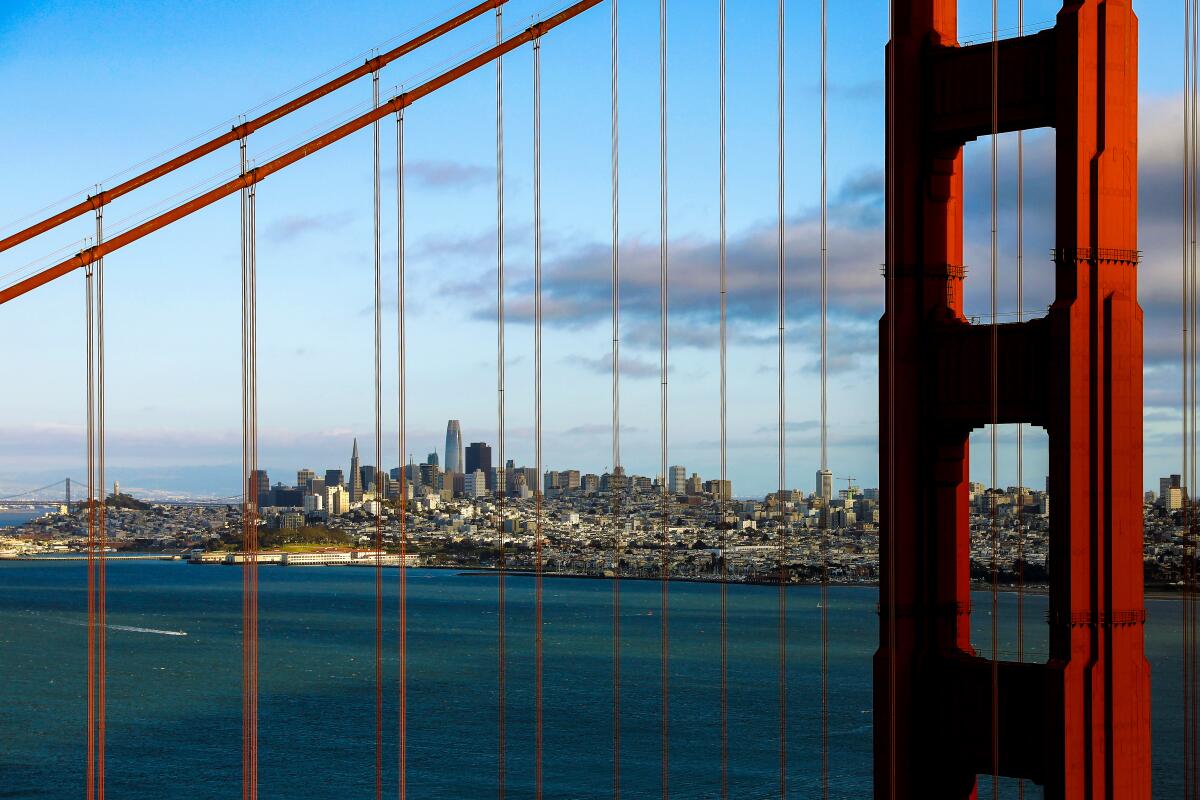
- Share via
It’s the weekend and I’m dreaming of sushi. I’m Carolina A. Miranda, arts and design columnist at the Los Angeles Times, and I’m serving up all the nigiri with a side of essential arts news:
The narrative of the ‘unfixable’ city
In the United States, we have several hallowed cultural traditions: driving large cars, watching movies with lots of explosions and dumping on cities — the latter activity reaching a fever pitch during presidential election years. New York, Chicago and Los Angeles have all served as rhetorical whipping boys. Now, it is San Francisco‘s turn.
“San Francisco Falls Into the Abyss” reads a recent dispatch on the website of the conservative Hoover Institution. Earlier this month, Elon Musk described the city as “post-apocalyptic.” And now we have a report by Elizabeth Weil in Curbed that bears the ominous headline: “Spiraling in San Francisco’s Doom Loop: What it’s like to live in a city that no longer believes its problems can be fixed.”
The story opens with Salesforce CEO Marc Benioff surveying “his kingdom” from the top floor of the new Salesforce tower in 2019, before moving on to a kickboxer who has left S.F. for reasons. It concludes with the deep thought: “Now, it was clear tech wouldn’t save us. Tech wouldn’t even stay in town. I rode the bus around the city, scribbling in my notebook: face of god, face of GOD, trying to keep myself open to the world as it fell apart.” (I’m not sure if it was the author’s intent to make me laugh.)

San Francisco — downtown San Francisco, to be specific — is facing some staggering urban problems generated, in part, by the pandemic. This was detailed in a lengthy report by the San Francisco Chronicle in March, which likewise used the “doom loop” narrative as a frame (though its story posits some solutions). The gist of it is this: As workers remain largely remote, offices remain underpopulated; downtown areas become ghost towns; neighborhood businesses close; the tax base shrinks, and with it social services, making the problems worse, leading more people to leave the city ... and you get the idea.
The problem is not unique to San Francisco. COVID-19 has had a similar effect on business districts in other cities, such as New York and Los Angeles. But none have been hit quite as hard as San Francisco, which, according to the Chronicle, remains the emptiest office market in the nation. Some of this has to do with the way San Francisco is zoned (downtown remains almost entirely commercial). Some of it has to do with the fact that the city’s economic wagons have been hitched to high-earning knowledge workers who skipped off the moment the pandemic landed. And a lot of it has to do with the fact that the city has done little to make itself more hospitable to lower- and middle-income wage earners — the very people who are more likely to stick around a city for the long haul.
And the unhoused population? It is not new. It’s perhaps simply more visible now that downtown San Francisco has grown quiet. Just peep this informative 2019 story by Matthew Green at KQED about how four decades’ worth of San Francisco mayors have dealt with the issue. Interesting fact: Swathes of the Mid-Market area were cleared under Ed Lee‘s mayoralty in the 2010s to woo tech firms.
Tech not only didn’t save San Francisco. It was complicit in propping up the scrim that kept the messiness of city life out of view.
Make the most of L.A.
Get our guide to events and happenings in the SoCal arts scene. In your inbox once a week.
You may occasionally receive promotional content from the Los Angeles Times.
What Weil’s story misses (besides a conversation with an actual urban planner) is that this difficult moment marks an opportunity for San Francisco to become a more equitable city. Not everyone is crying over the doom loop, which has brought down real estate prices from mind-numbingly astronomical to a hair above unaffordable. As the Chronicle’s Noah Arroyo notes in a recent report: “Some hope the decline will lower the cost of housing so they and others can afford to move to the city — or avoid having to leave — after persistently high prices pushed or kept them out for years, or had them barely making the rent.” His story concludes with a young woman who was able to return to the Mission to live near her parents.
SPUR, the San Francisco Bay Area Planning and Urban Research Association, has a list of four policy ideas for helping revitalize San Francisco’s downtown. Among them: diversifying land use and investing in public transit. I would also recommend this interview with sociologist David Madden by Alissa Walker (right in Curbed!), who notes that it’s a mistake to conflate the “urban general good and the good of downtown real-estate owners” — and proceeds to offer a host of ideas for how urban downtowns might reemerge from the pandemic.
In January, California State Assembly member Alex Lee (D-San Jose) introduced a bill to encourage the development of social housing in California — housing geared at accommodating a mix of household income ranges. It’d be interesting to consider how a statute of that nature could support commercial-to-residential conversions (and how those could be made affordable to the average mortal).
Weil writes that San Francisco needs a shared project: “museums, a university, people, community.” Housing for those communities would be a good place to start; museums, not so much. (Another interesting fact: SFMOMA and the Yerba Buena Center for the Arts were built on a literal graveyard of demolished single room occupancy hotels.)
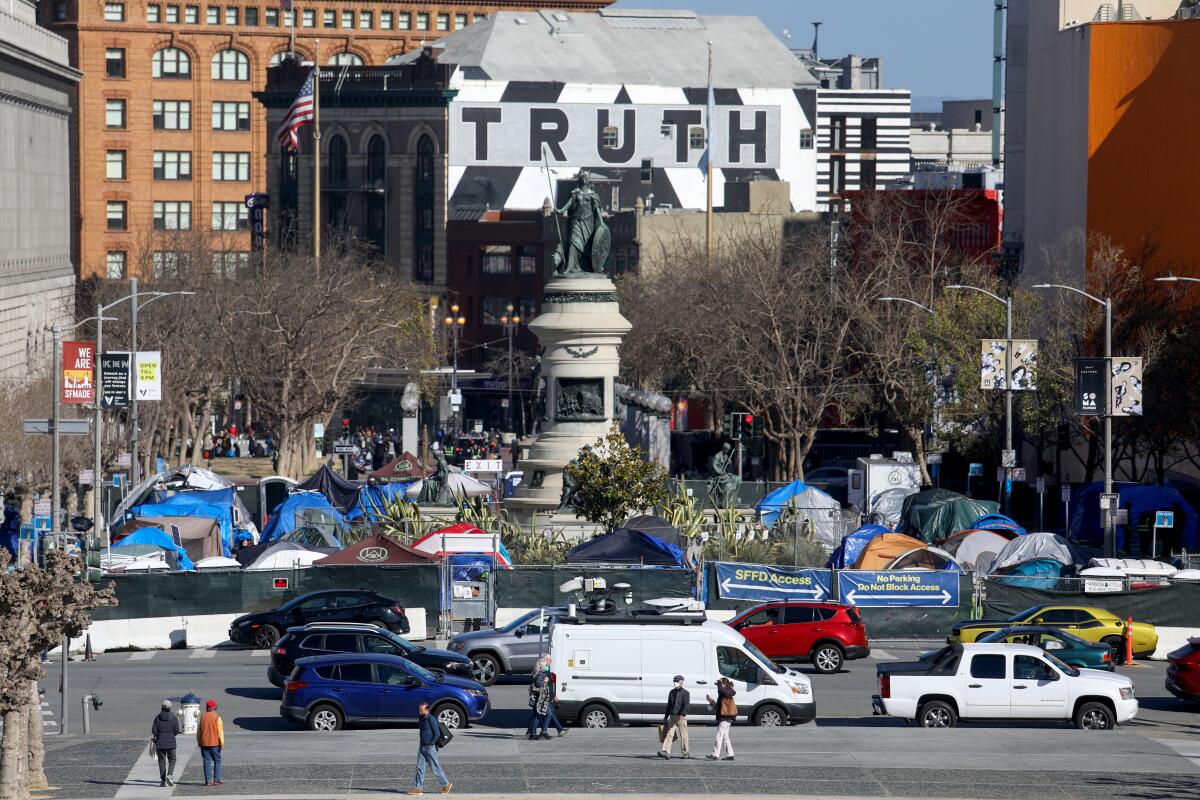
The problems are big and will not be easy to resolve. But throwing our hands up in the air and shouting “doom loop” is not only unhelpful, it contributes to an anti-cities rhetoric that is often just thinly veiled racism.
For some, a San Francisco without a Whole Foods on Market Street is a hollowed-out city. For countless others, it was the tech wealth that did the hollowing to begin with — driving up rents, displacing communities, gutting longtime cultural and social services organizations.
In her 2000 book, “Hollow City: The Siege of San Francisco and the Crisis of American Urbanism,” Rebecca Solnit wrote about the ways the tech industry reshaped the landscape of her beloved city. Nearly a quarter-century later, the book reads like a road map to 2023.
“Wealth,” she writes, “has proven able to ravage cities as well as or better than poverty.”
In the galleries
“I think of the studio as a gut,” says artist Max Hooper Schneider, “and I’m like a digestive enzyme, circulating through it.” The artist is the subject of a solo at François Ghebaly gallery in downtown Los Angeles that will feature his “disorienting vistas.” Times contributor Leah Ollman describes these sculptures, which depict miniaturized worlds, as “microcosmic scenarios that allude to macrocosmic phenomena of ecological, biological, anthropological and sociological distress.” Sounds like she had quite the studio visit.
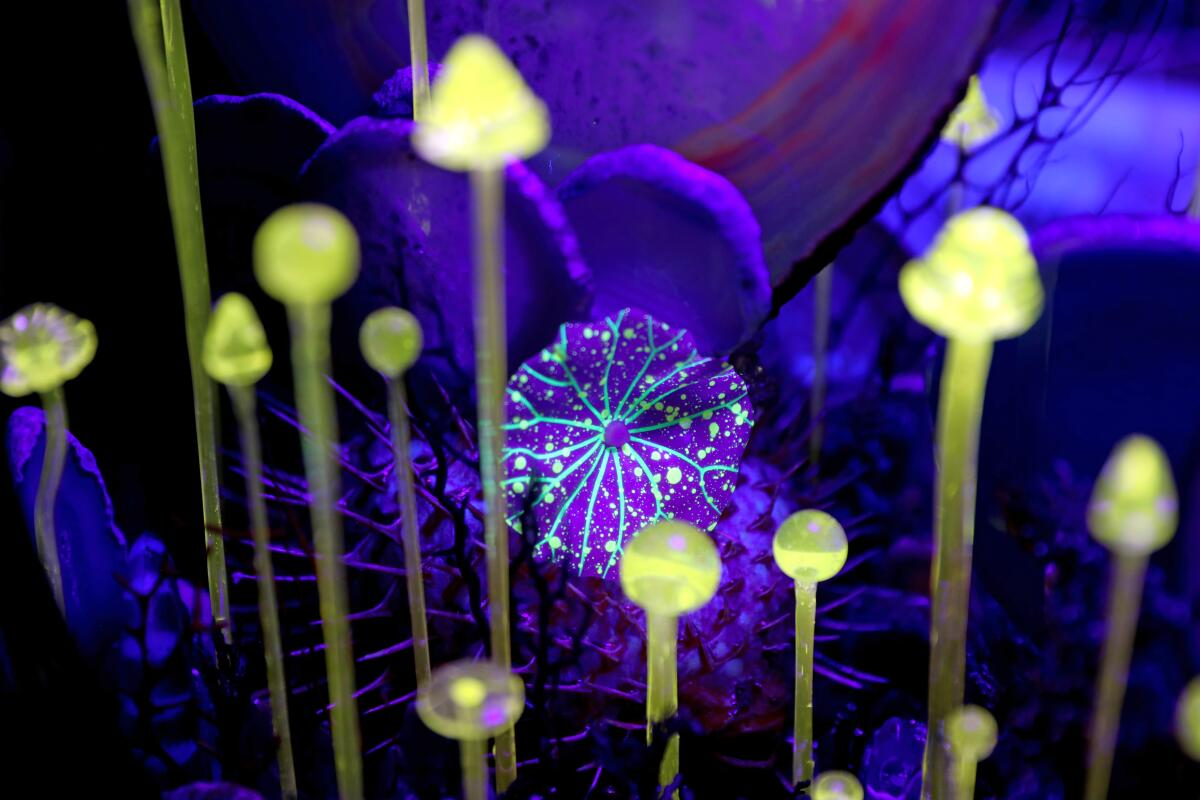
“Witness” is a group show on view at the WACO Theater Center that brings together 14 Black women and nonbinary artists exploring the ways they see themselves. Organized by Tina Knowles Lawson and Genel Ambrose, it was inspired in part by a passage from a 1971 essay by Toni Morrison: “And she had nothing to fall back on: not maleness, not whiteness, not ladyhood, not anything. And out of the profound desolation of her reality she may very well have invented herself.” Contributor Leigh-Ann Jackson reports on the work and inspirations of the artists involved in the show.
Long Beach is moving forward on plans to establish a Cambodian American Cultural Center. The next step includes establishing a nonprofit to coordinate finding a location, raising funds and developing programming.
Classical notes
Remember that story about a woman reportedly having an orgasm while listening to the L.A. Phil? My colleague Steven Vargas follows up with a short history on how audiences have responded to performances historically. “Sitting in complete silence while taking in a theatrical performance,” he reports, “is a fairly new phenomenon.” His story is a fascinating trip that covers sexist 19th century theories about women and music as well as anecdotes of restive crowds throwing food at the stage.
Enjoying this newsletter? Consider subscribing to the Los Angeles Times
Your support helps us deliver the news that matters most. Become a subscriber.
Department of delayed apologies
In 2000, my colleague Deborah Vankin sat down to profile writer Thomas Beller for L.A. Weekly. He was really late and not very nice. (You can read that profile here and it is very much worth it.) Twenty-three years later he’s back with a new book, “Lost in the Game: A Book About Basketball” — as well as an apology for Vankin, who is now a staffer at The Times. “How much of Beller’s apology was a play for book event publicity?,” writes the wary Vankin. “While I don’t fault any author for being proactive about DIY publicity in these days of cash-strapped publishing, bundling it into a retroactive apology felt dubious.” A story about an apology that is also a story about where we all were in 2000. (Checking voicemail and reading dude lit.)
Design time
A design evoking a stark ghost forest has been chosen as the winning concept for a memorial to honor the victims of the Chinese Massacre of 1871. Devised by artist Sze Tsung Nicolás Leong and writer Judy Chui-Hua Chang, the concept was inspired by the banyan trees that guard the entrances to villages in Guangdong, where many early Chinese immigrants to L.A. originated.
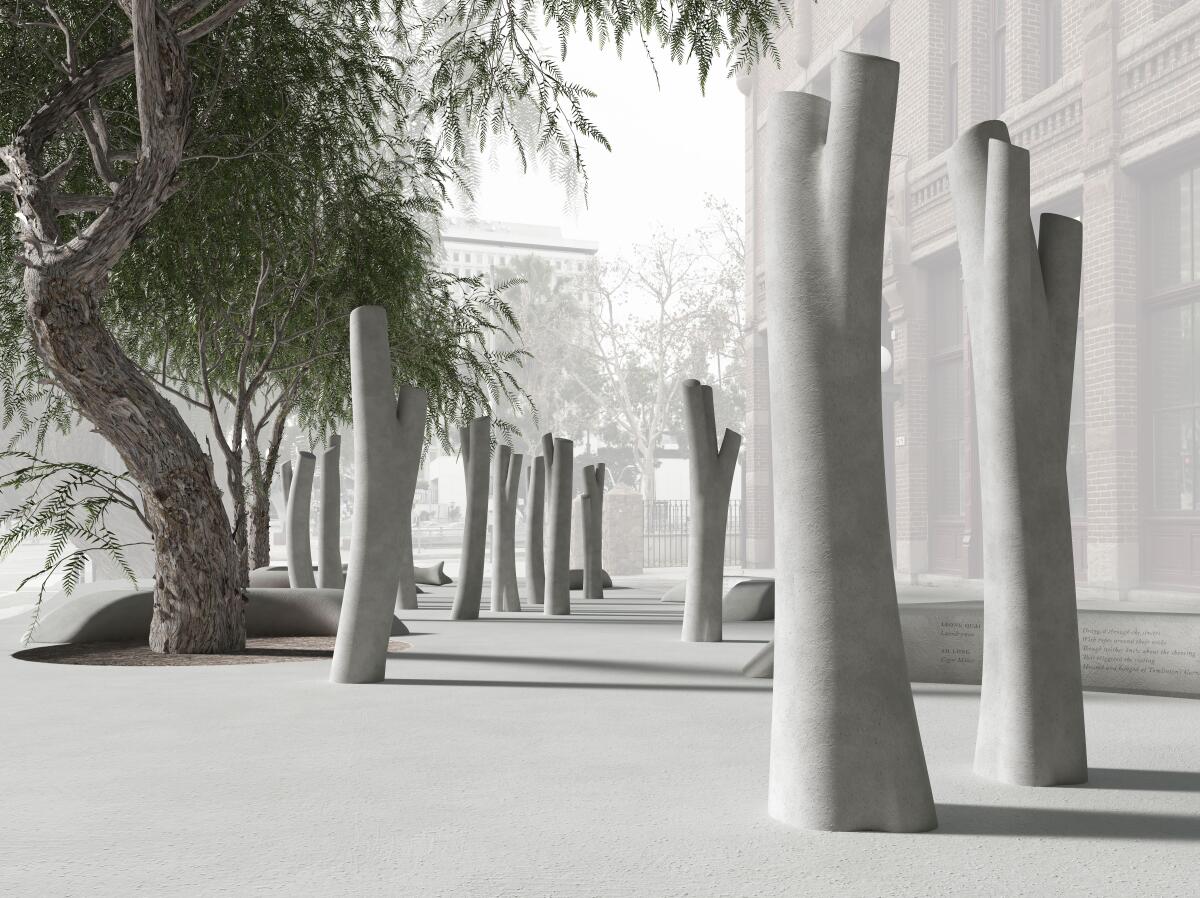
Can downtown L.A.’s garment industry survive the downtown condo boom? David Wagner has an interesting story in LAist.
Essential happenings
The Times’ summer preview section lands this weekend and The Times fine arts team has put together a list of essentials so you can plan the season — from performances at the Hollywood Bowl to a show at the Cheech.
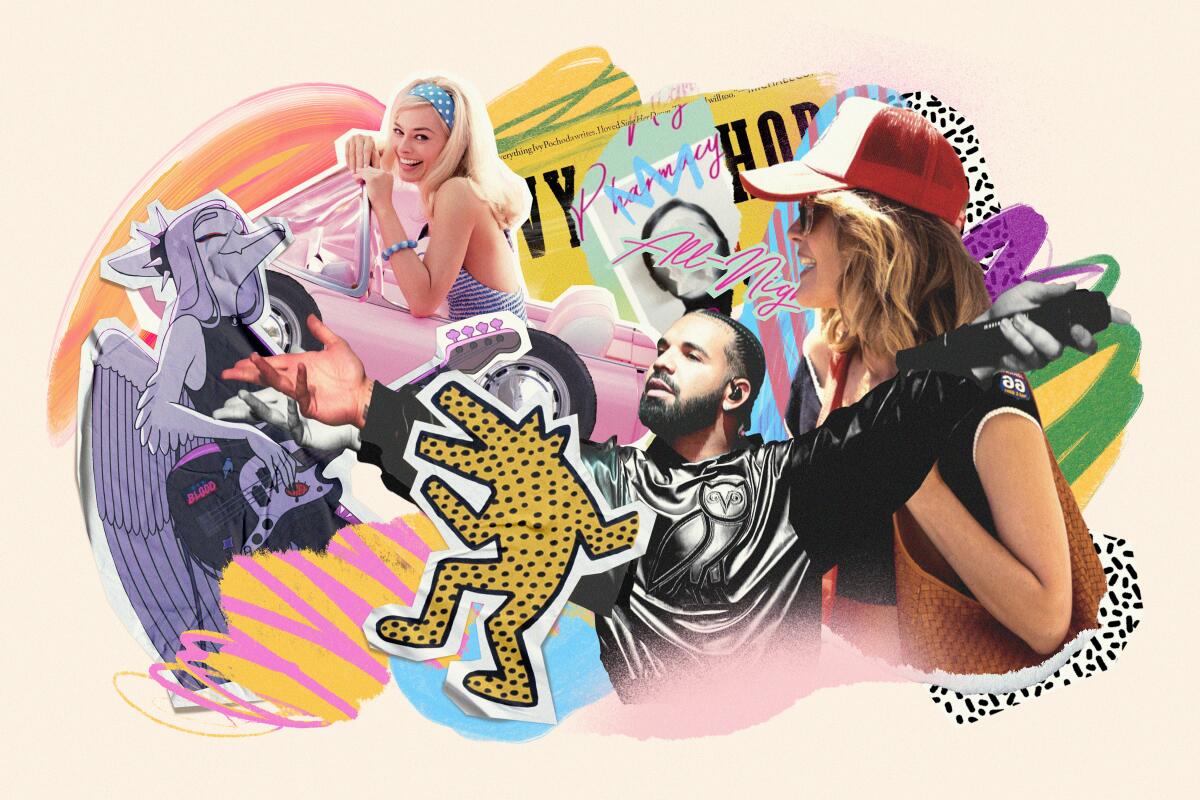
In his weekly L.A. Goes Out newsletter, Steven Vargas rounds up the latest art happenings, including performances by L.A. Dance Project and Blue13 Dance Company.
Matt Cooper has all the Mother’s Day events, including mom-themed comedy shows and musicals, as well as a Mother’s Day recital by the Seal Beach Symphony on Sunday.
And Marsha Takeda-Morrison has compiled a roundup of 10 important L.A. buildings you can visit on a tour.
Moves
The Getty announced this week that it will be issuing an additional $17 million in grants for arts organizations for the next iteration of Pacific Standard Time and tweaking the initiative’s name to “PST Art.” The next series, which will launch in September 2024, is focused on the juncture of art and science. The Times’ Deborah Vankin has the lowdown on the shows being planned.
There are lots of staffing changes at the Hammer Museum. Chief curator Connie Butler is leaving to become director of MoMA PS1 in New York and senior curator Aram Moshayedi will be headed to Mexico City to serve as curator in residence at the Tamayo Museum (though he will remain at the Hammer as an adjunct). Joining the museum full-time will be Pablo José Ramírez, who is serving as co-curator of the upcoming Hammer biennial. Plus, Erin Christovale has been bumped up to curator. The Times’ Christopher Knight gets into all the changes.
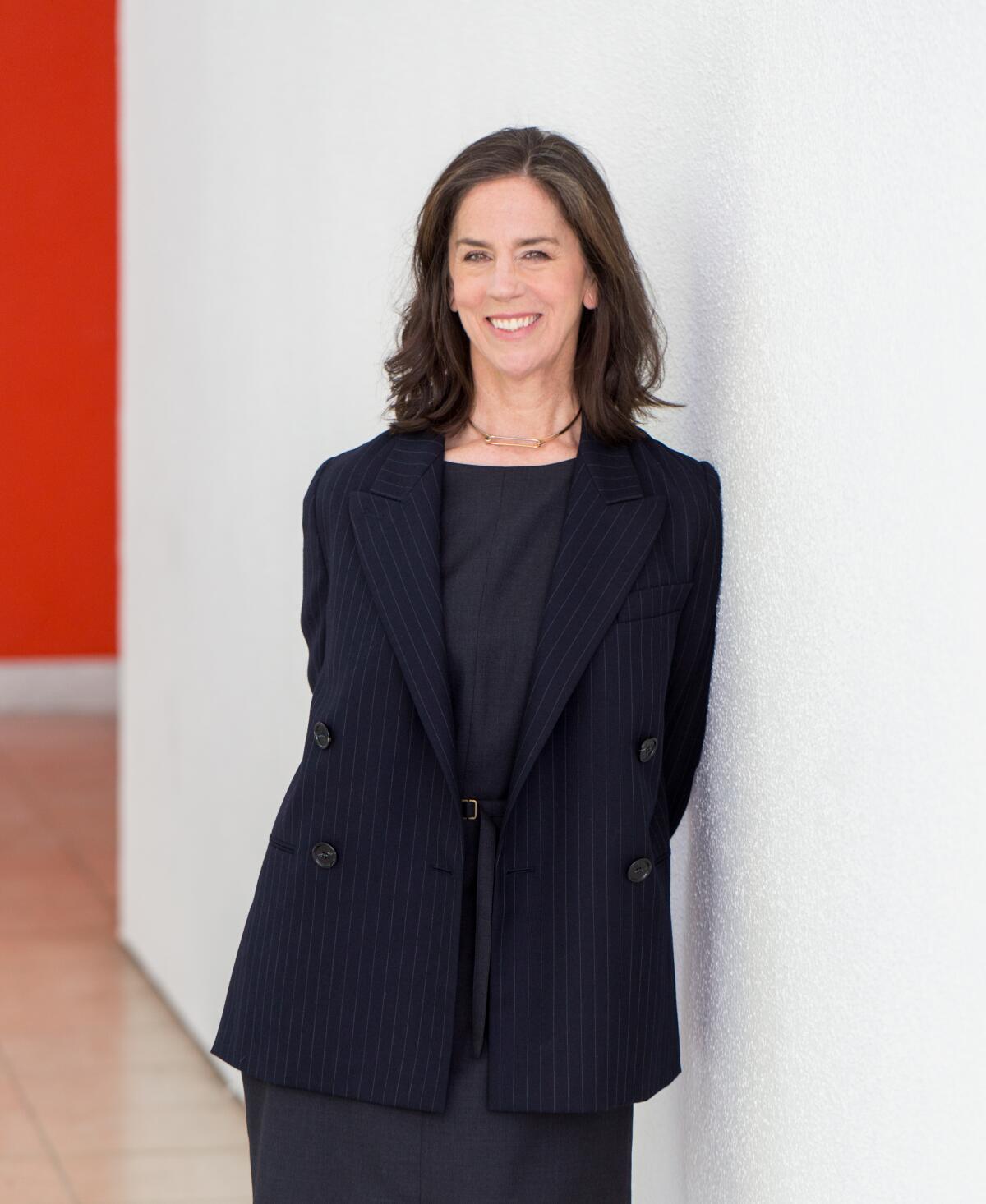
Margaret Tracey, formerly a New York City Ballet principal and director of Boston Ballet School, has been named dean of the Trudl Zipper Dance Institute at the Colburn School.
The Ford Foundation is teaming up with the Alice L. Walton Foundation, the Mellon Foundation and Pilot House Philanthropy to fund an initiative that will support racial equity in leadership roles in art museums.
The Ruth Foundation for the Arts has announced its 2023 grant recipients, which this year include the World Stage in Leimert Park and the Chinatown art space Human Resources L.A.
Arts Orange County has announced its 2023 honorees for its annual art awards; they include flamenco dancer Claudia de la Cruz and patron Jane Fujishige Yada.
The Huntington has acquired a landscape by David Hockney, “Tree on Woldgate, 6 March,” 2006 — a gift made in honor of the late L.A. art book dealer Dagny Janss Corcoran.
Pulitzer Prizes
The Times won not one but two Pulitzer Prizes this week! One was for a team of reporters that worked on a package of stories related to the city council leaks; another went to one of my regular collaborators, Christina House, for her stellar feature photography.
Two novels — Barbara Kingsolver‘s “Demon Copperhead” and Hernan Diaz‘s “Trust” — shared the prize for fiction, while Robert Samuels and Toluse Olorunnipa‘s “His Name Is George Floyd” nabbed the award for nonfiction. Hua Hsu‘s “Stray True” won for memoir. The Times’ Jonah Valdez reports on some of the other winning book categories, including biography, history and poetry.
Plus, Rhiannon Giddens and Michael Abels took home the prize for music, for their opera “Omar.” When the opera was presented in L.A. last fall, Times theater critic Charles McNulty wrote that “of all the music being composed today, hers might be the clearest expression of the American experiment, in all its varied hues and tonalities.”

Passages
Chris Strachwitz, a historian who traveled the United State in search of little-known performers for the Arhoolie label, has died at 91.
MTV News, the outlet that covered everything from presidential elections to the VMAs, in the process becoming a Gen-X cultural touchstone, has been shut down by Paramount Global after four decades. Former VJ Dave Holmes pays tribute.
I’d like to give a shout-out to this great MTV News piece from 2017 by Marcus Patrick Ellsworth about a pride parade in Casper, Wyo. — a dispatch that has stayed with me.
In the news
— The best essay I’ve read on the coronation is by Canadian novelist Stephen Marche.
— A profile of Lesley Lokko, the first curator of African descent to curate the Venice Architecture Biennale.
— Architecture critic Alexandra Lange dives into the expansion of the American Museum of Natural History by Studio Gang. The building, she writes, “feels like a valiant attempt to reconcile a 150-plus-year-old museum’s worth of contradictions.”
— The home as Amazon distribution warehouse: Kelly Pendergrast on Khloe Kardashian’s pantry and much much more.
— “New Angle: Voice” devotes its latest episode to Ada Louise Huxtable, whose archives are held at the Getty.
— Is national conflict good for artmaking? Pablo Helguera dives in with an essay about art, cultural stereotypes and the history of cuckoo clocks.
— Speaking of clocks, the film noir classic “The Big Clock” features a character partly inspired by Alice Neel. A good jam from Ben Davis.
— New York’s Metropolitan Museum of Art is hiring a provenance research team to review the collection in the wake of seizures by law enforcement.
— I didn’t know much about “king of toxic masculinity” Andrew Tate when he was arrested in Romania, so the four-part series on his rise by the “Behind the Bastards” podcast was illuminating. Start with Episode 1, which gets into the mythopoetic men’s movement that set the stage for Tate and his ilk.
And last but not least ...
I’m here for the 1970s Walk of Fame photos of Ave Pildas.
The biggest entertainment stories
Get our big stories about Hollywood, film, television, music, arts, culture and more right in your inbox as soon as they publish.
You may occasionally receive promotional content from the Los Angeles Times.




